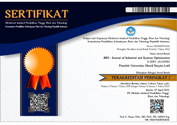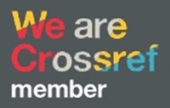ANALISIS HUBUNGAN PERSEPSI KARYAWAN TERHADAP PROGRAM K3 DENGAN STRESS KERJA SEBAGAI VARIABEL INTERVENING
DOI:
https://doi.org/10.51804/jiso.v4i2.109-115Keywords:
K3 program, work accident, workload, work stress, PLS-SEMAbstract
PT. X is a manufacturing company that is engaged in smelting, metal rolling and producing products in the form of iron and concrete in the implementation of its production. This research was conducted to determine how much influence the perception of the work environment has on work stress, perceptions of workload on work stress, perceptions of work accidents on work stress, and how much influence work stress has on occupational safety and health programs for employees of PT. X Data analysis in this study uses the Partial Least Square – Structural Equation Modeling (PLS – SEM) approach with SmartPLS 3 software as an analytical tool. The first hypothesis is that the work environment variable (X1) on work stress (Y1) gets a T-count value of 2.134 with significant 0.033 <0.05. The first hypothesis of the workload variable (X2) on work stress (Y1) gets a T-count value of 0.178 with a significant value of 0.074> 0.05. The first hypothesis of the work accident variable (X) on work stress (Y1) got a T-count value of 2.957 with a significant value of 0.003 <0.05. The first hypothesis of the work stress variable (Y1) on the K3 Program (Y2) got a T-count value of 42.411 with a significant value of 0.000 <0.05.
Abstrak
PT. X adalah suatu perusahaan manufaktur yang berkecimpung di sektor peleburan, pengerolan logam dan menghasilkan produk berupa besi beton dalam pelaksanaan produksinya penelitian ini dilakukan untuk mengetahui seberapa pengaruh persepsi lingkungan kerja terhadap stres kerja, persepsi beban kerja terhadap stress kerja, persepsi kecelakaan kerja terhadap stress kerja, dan Seberapa besar pengaruh stress kerja terhadap program keselamatan dan kesehatan kerja pada karyawan PT. X Analisis data pada penelitian menggunakan pendekatan Partial Least Square – Structural Equation Modeling (PLS – SEM) dengan software SmartPLS 3 sebagai alat bantu analisis Hipotesis pertama variabel lingkungan kerja (X1) terhadap stress kerja (Y1) mendapat nilai T-hitung sebesar 2,134 dengan nilai signifikan 0,033<0,05. Hipotesis pertama variabel beban kerja (X2) terhadap stress kerja (Y1) mendapat nilai T-hitung sebesar 0,178 dengan nilai signifikan 0,074>0,05. Hipotesis pertama variabel kecelakaan kerja (X) terhadap stress kerja (Y1) mendapat nilai T-hitung sebesar 2,957 dengan nilai signifikan 0,003<0,05. Hipotesis pertama variabel stress kerja (Y1) terhadap Program K3 (Y2) mendapat nilai T-hitung sebesar 42,411 dengan nilai signifikan 0,000<0,05.
References
Arianto, D., & Puspita, A. D. (2019). Pengaruh Shift Kerja Terhadap Kinerja Melalui Variabel Kelelahan Dan Beban Kerja Sebagai Variabel Intervening Di Pt M.I. JISO : Journal of Industrial and Systems Optimization, 2, 23–28. https://doi.org/10.51804/jiso.v2i1.23-28.
Hanil, P. T., & Steel, J. (2019). Sistem aplikasi pendataan karyawan pada pt. hanil jaya steel.
Irwan & Idris, A. (2019). Analisis Structural Equation Modelling dan Terapannya. Jurnal Teknosains, 8 Nomor 2, 137–151.
Kurniawan, A., Fahrurazi, & Rahman, E. (2020). Hubungan Persepsi Beban Kerja Dengan Stres Kerja Karyawan Pt.Bank Kalsel Cabang Utama Tahun 2O2O. 1–8.
Muhammad Amin. (2020). Analisis Lingkungan Kerja Dan Disiplin Kerja Terhadap Kinerja Pegawai Pada Dinas Kebudayaan Pariwisata Pemuda Dan Olah Raga Kabupaten Bungo.
Rizki, M., Hamid, D., & Mayowan, Y. (2021). Pengaruh Lingkungan Kerja Terhadap Stres Kerja Karyawan (Studi Pada Karyawan PT PLN (Persero) Distribusi Jawa Timur Area Pelayanan Malang). Jurnal Administrasi Bisnis S1 Universitas Brawijaya, 41(1), 9–15.
Susetyo, R. I., & Ratnaningsih, I. Z. (2016). Persepsi Terhadap Keselamatan Dan Kesehatan Kerja Dan Stres Kerja Pada Karyawan Bagian Produksi Pt X Di Bekasi. Empati: Jurnal Karya Ilmiah S1 Undip, 5(1), 55–59.
Downloads
Published
Issue
Section
License
With the receipt of the article by JISO Editorial Board and the decision to be published, the copyright regarding the article will be transferred to JISO. The copyright transfer form can be downloaded here.
JISO has the right to multiply and distribute the article and every author is not allowed to publish the same article that was published in this journal.
JISO is licensed under a Creative Commons Attribution-ShareAlike 4.0 International License.
Under the following terms:
Attribution — You must give appropriate credit, provide a link to the license, and indicate if changes were made. You may do so in any reasonable manner, but not in any way that suggests the licensor endorses you or your use.
ShareAlike — If you remix, transform, or build upon the material, you must distribute your contributions under the same license as the original.














